Precision and accuracy are two common terms in the area of machining measurements. While they’re often used interchangeably in colloquial conversations, they hold distinct meanings, especially in disciplines like manufacturing and engineering. Understanding the difference between accuracy and precision is vital for industries that hinge on exact measurements. Through this article, we will dissect each term, and its implications in manufacturing, and explore how they intertwine with engineering tolerances.
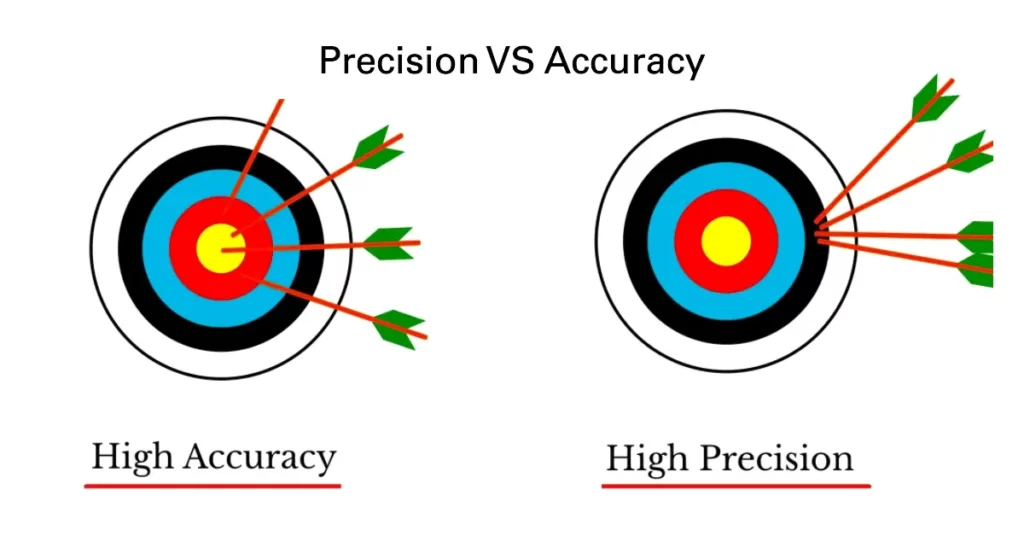
What is Precision?
In the vast lexicon of terms that engineers, manufacturers, and scientists rely upon, the word “precision” holds a pivotal place. Precision shows consistency, repeatability, and reliability, paramount in various scientific and industrial activities. But what exactly does precision entail? Let’s delve deeper into its layers.
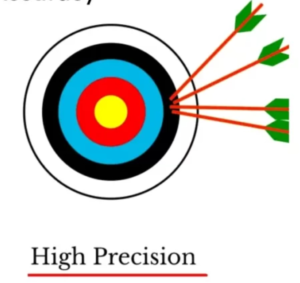
Precision, in its simplest form, refers to the degree to which repeated measurements or experiments produce the same results. It doesn’t necessarily indicate that these measurements are correct—just that they’re consistent. It’s the idea of repeatedly hitting the same spot, irrespective of whether that spot is the intended target.
Let’s break this down further:
- Consistency: Precision underscores the importance of consistency in measurements, which provides a level of trust in equipment or procedures.
- Repeatability: Precision also refers to the ability to replicate a result using the same methodology, which speaks to the reliability of a method or tool.
- Reliability: Instruments with high precision can be trusted to produce almost identical outcomes in repeated tests under unchanged conditions.
Example of Precision with Values
Imagine experimenting to measure the boiling point of water under specific conditions. Over multiple trials, you record the following boiling points (in degrees Celsius):
Table: Measurement data
| Trial Number | Boiling Point (°C) |
|---|---|
| 1 | 100.2 |
| 2 | 100.3 |
| 3 | 100.1 |
| 4 | 100.3 |
| 5 | 100.2 |
The values are tightly clustered around 100.2°C, indicating high precision. Even if the actual boiling point was slightly different (which would be a question of accuracy), the results are undeniably consistent.
Precision often gets confused with other terms, especially accuracy. Here’s a comparative perspective:
- Precision vs. Accuracy: While precision denotes consistency, accuracy means hitting the correct mark. An instrument can be precise (consistent results) without accuracy (right results).
- Precision vs. Resolution: Resolution is the smallest measurable Value. High resolution doesn’t necessarily mean high precision.
What is Accuracy?
Accuracy emerges as a testament to the correctness of a measurement. In technical terms, accuracy denotes how close a measurement is to the actual Value. It’s a reflection of the correctness of a measurement rather than its repeatability. Essentially, accuracy relates to the quality of being correct or precise.
To further elucidate:
- Correctness: Accuracy is getting results close to the established standard or actual Value.
- Deviation: The less the deviation from the actual Value, the higher the measurement accuracy.
- Absolute Value: Accuracy is rooted in getting to the whole, unvarnished truth in measurements.
Examples of Accuracy in Manufacturing
To comprehend accuracy in a manufacturing context, consider the production of steel rods supposed to measure precisely 10.0 cm in length:
Table: Accuracy example
| Rod Number | Measured Length (cm) | Actual Value (cm) | Deviation from True Value (cm) |
|---|---|---|---|
| 1 | 10.02 | 10.0 | +0.02 |
| 2 | 9.98 | 10.0 | -0.02 |
| 3 | 10.01 | 10.0 | +0.01 |
| 4 | 9.99 | 10.0 | -0.01 |
| 5 | 10.03 | 10.0 | +0.03 |
The table shows that the rods’ lengths are close to the actual Value. Their deviations are minimal, suggesting a high level of accuracy in the manufacturing process.
The concept of accuracy often intertwines with other terms. Drawing clear lines of distinction is crucial:
- Accuracy vs. Precision: Precision denotes repeatability. An instrument can be accurate (hits the target) without being precise (hits the same spot every time).
- Accuracy vs. Tolerance: Tolerance is the allowable limit of variation in manufacturing. Accuracy ensures that measurements fall within these specified tolerances.
Precision, Accuracy, and Tolerances in Engineering Drawings
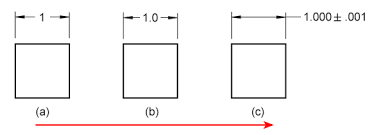
Accuracy, precision, and tolerances
Engineering drawings are the blueprint for the vast array of structures and products we see daily. Ensuring these drawings are precise, accurate, and within acceptable tolerances is pivotal.
1. The Bedrock of Precision in Drawings
Precision in engineering drawings refers to the granularity or detail level showcased. Higher accuracy means the picture captures more details, often requiring more advanced tools or techniques.
Significance of Precision
- Ensures that minute details are not overlooked.
- Facilitates better decision-making during the manufacturing process.
- Enhances clarity for engineers and technicians.
2. Advocating Accuracy in Engineering Representations
Accuracy in engineering drawings determines how well the depicted details match real-world parameters or intentions. It’s about ensuring the representation is correct and mirrors the design intent.
- Championing True Representations: Ensures that the final product or structure aligns with the design intent, minimizes errors in the production or construction phase, and builds trust among stakeholders, as the drawing becomes a reliable reference point.
- Elements Dictating Drawing Accuracy: Calibration of drawing tools and Peer reviews or software validations can spot inaccuracies.
3. Tolerances: The Acceptable Limits
In engineering, tolerances define the permissible limits within which a particular dimension can vary. Tolerances are vital as they acknowledge that no production process is perfect. They give a range within which a measurement can deviate and still be acceptable.
Related: Tolerances in CNC Machining
Table: Various drawing elements related to precision and accuracy
| Topic | Sub-Topic | Description | Example/Indication |
|---|---|---|---|
| Tolerance Types in Drawings | Bilateral Tolerance | Denotes an upper and lower limit | 10±0.5 means the range is 9.5 to 10.5 |
| Unilateral Tolerance | Allows only one-sided deviation | 10+0.5 means between 10 and 10.5 | |
| Incorporating Tolerances | Dimension Indication | Typically indicated next to the dimension | Range or symbols on the drawing |
| Symbolic Denotation | Symbols or notes denote specific tolerances | Tolerance-related symbols or notes | |
| Drawing Element | Dimension Lines | Granularity of divisions | Range or symbols |
| Geometric Details | Handles the complexity of design | Specific notes for accurate representation | |
| Annotations | Level of detailed information | Tolerance-related symbols or specific notes |
This table should make the information more transparent and organized, helping readers understand the relationship and distinctions between the elements related to tolerances in engineering drawings.
The Interplay Among Precision, Accuracy, and Tolerance
While these terms often intertwine, they serve distinct roles:
Table: Concepts and their differences
| Comparison | Aspect 1 | Aspect 2 | Example/Clarification |
|---|---|---|---|
| Precision vs. Accuracy | Detail-oriented | Correctness-oriented | Drawing: Precise in detail but might not match real-world measurements |
| Accuracy vs. Tolerance | Conformity to value | Acceptable deviation | Dimension: Matches design but might be outside the accepted range |
| Precision vs. Tolerance | Level of detail | Deviation range | High precision captures minor deviations, potentially within tolerances |
Difference Between Accuracy and Precision
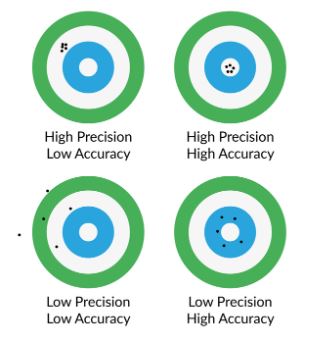
Concept of accuracy and precision
In everyday parlance and technical domains, ‘accuracy’ and ‘precision’ are often used interchangeably. However, they refer to distinctly different scientific, engineering, and manufacturing concepts.
Table: Comparing Accuracy and Precision
| Aspect | Accuracy | Precision |
|---|---|---|
| Definition | How close a measurement is to the actual or accepted value. | Consistency or repeatability of measurements, irrespective of their closeness to the actual value. |
| Illustration | Hitting the bullseye on a dartboard. | It hit the same spot repeatedly, even if it was not the bullseye. |
| Key Focus | Correctness | Consistency |
| Real-world Example | A scale meant to measure 500 grams. It is accurate if it consistently reads 500 grams for a 500-gram standard weight. | A scale consistently reads 510 grams when a 500-gram weight is placed on it. The readings are precise (consistent) but not accurate. |
| Relevance in Manufacturing | We are ensuring products or parts align with design intent or standards. | Making sure a manufacturing process can produce consistent outcomes, reducing variability. |
| Tools/Devices Implication | An accurate tool or device gives results close to the actual value. | A precise tool or device can give the same result multiple times under the same conditions. |
| Impact of Errors | Systematic errors can often be identified and corrected. | Random errors might be more challenging to pinpoint and require finer calibration or improved methods. |
Importance of the Accuracy and Precision Concept in Manufacturing
Manufacturing industries have always prioritized two key concepts: accuracy and precision. Both play vital roles in ensuring the production of high-quality, consistent, and safe products.
Table: How Accuracy and Precision Impact Manufacturing Metrics
| Metrics | Impact of Accuracy | Impact of Precision |
|---|---|---|
| Waste Levels | Reduced when products match design specifications | Lowered with a consistent production output |
| Customer Returns | Drop with products meeting described standards | Decrease with uniform product quality |
| Safety Incidents | Reduced with adherence to design | Mitigated by consistent quality and specifications |
| Regulatory Compliance | Achieved through exact production | Maintained with consistent quality checks |
ProleanTech Precision & Accuracy: A Commitment to Excellence
When it comes to manufacturing, there’s no room for compromise on precision and accuracy. At ProleanTech, we understand the importance of these twin pillars in delivering optimal outcomes for our clients.
Whether you need intricate components for the aerospace industry or delicate parts for medical devices, ProleanTech ensures every product is both precise and accurate. Our commitment to quality doesn’t just stop at ensuring measurements are spot on; it’s about guaranteeing every item we produce meets the highest standards of excellence.
Why choose ProleanTech for precision and accuracy?
- Advanced Equipment: Our state-of-the-art machinery ensures that every cut, mold, or assembly is performed precisely.
- Expertise & Knowledge: Our seasoned professionals have years of experience ensuring accurate outputs in every project.
- Quality Assurance: With rigorous checks and a keen eye for detail, we ensure every product aligns with the desired specifications.
- Tailored Solutions: Our team collaborates closely with clients, ensuring solutions are tailored to individual needs while maintaining accuracy and precision.
Conclusion
Precision and accuracy, while closely related, differ in their essence. Precision revolves around consistency, whereas accuracy centers on correctness. In industries where measurements influence the outcome – whether in manufacturing a gadget or a spacecraft component – understanding and emphasizing these concepts becomes paramount. As consumers become more discerning and industries more competitive, the ability to consistently produce accurate and precise products will undoubtedly separate the best from the rest. Companies like Prolean’s Precise Machining Services understand this intricacy and prioritize both precision and accuracy, ensuring products that aren’t just well-made but also reliable.
FAQs
What’s the primary difference between accuracy and precision?
While accuracy is about correctness (hitting the target), precision is about consistency.
Can a measurement be precise but not accurate?
Yes, if repeated measurements are consistent but far from the true value, they are precise but inaccurate.
How does tolerance relate to accuracy and precision?
Tolerance defines allowable deviations from a specified value, bridging the concepts of accuracy and precision.
Why are both precision and accuracy vital in manufacturing?
They ensure product quality, functionality, cost efficiency, and, in specific industries, safety.
Can a manufacturing process be both highly precise and highly accurate?
Many modern manufacturing processes achieve high precision and accuracy with advanced tools and techniques.
How does Prolean’s Precise Machining Services ensure precision and accuracy?
Through rigorous quality checks, state-of-the-art equipment, and skilled professionals, Prolean ensures both accuracy and precision in its machining processes.

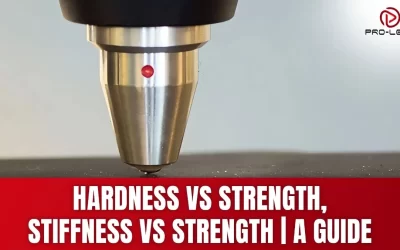
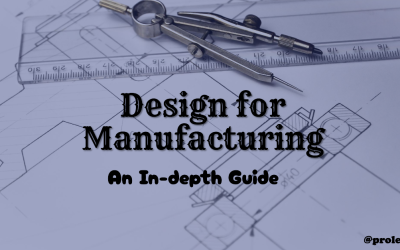

I have to express some thanks to you for bailing me out of this incident. Just after researching through the world-wide-web and obtaining recommendations which were not powerful, I believed my life was well over. Existing without the strategies to the difficulties you have resolved by way of this article content is a critical case, and ones that might have negatively affected my entire career if I had not encountered the blog. Your training and kindness in controlling all the details was crucial. I am not sure what I would have done if I hadn’t come upon such a solution like this. I can at this time look forward to my future. Thank you very much for the high quality and results-oriented help. I will not hesitate to suggest your blog post to any person who should receive direction about this problem.
Thanks for your kind words. It was great to know that the article was helpful for you!